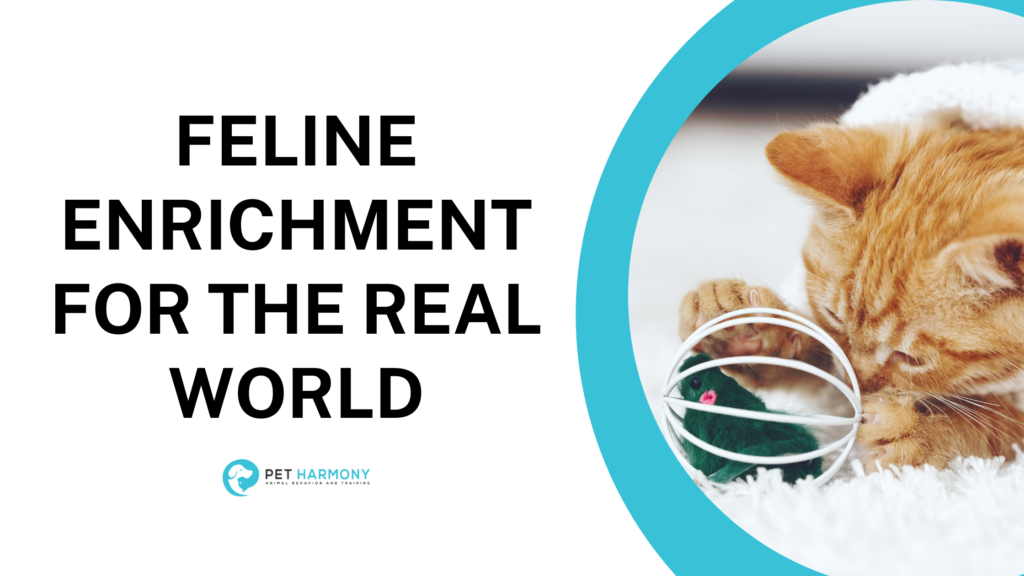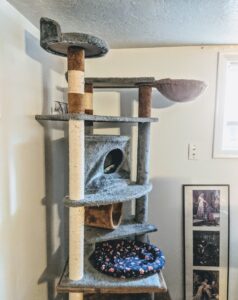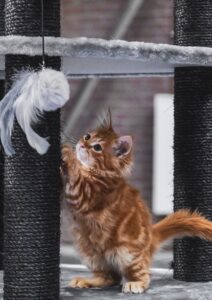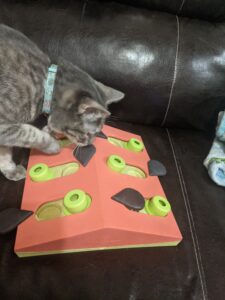
What is Enrichment?
At Pet Harmony, we talk about enrichment all the time, but if you’re a new cat owner, or just recently joining us, we need to define enrichment. It’s more than just Kongs and toys. Enrichment, as described in episode one of our all-new podcast, is “meeting all of an animal’s needs in order for them to be physically, behaviorally, and emotionally healthy enough to perform species-typical behaviors in safe, healthy, and appropriate ways.” Go listen to Episode 1 of Enrichment for the Real World for more on that!
So, like canine enrichment, feline (cat) enrichment needs to be specific to them. Just because something works for a dog, doesn’t mean it will work for a cat — and just because a certain activity helps one cat, doesn’t mean it will work for another. We need to provide cat-specific enrichment to have a healthy cat. When our cat is healthy, our relationship with them is so much better.
Typical Feline Behavior
Anytime I am trying to figure out what species-typical behaviors are, it is important to research the species. When we know what an animal usually does, we can give them ways to meet those needs that don’t compromise their physical, emotional, and behavioral health — or our own.

Here are some behaviors cats typically perform:
- Dig around in loose substrate in order to urinate and defecate.
- Bury or hide their urine and feces in said substrate
- Groom or “bathe” themselves
- Scratch on things
- Jump and climb
- Hang out in elevated spaces
- Hideout in small spaces
- Eat multiple small meals in a day
- Follow a hunting cycle of stalk, pounce, eat, groom, sleep
- Bat small objects with their paws, sometimes causing them to fall
Notice that I said these are some things cats typically do. Not all cats do all these things, and I also didn’t list all the things cats do. These are just some very interesting areas that can become problematic for your home if your cat doesn’t have an outlet.
How Do I Provide Enrichment for a Cat, and Why Does it Help?
If your cat is performing a species-typical behavior in a way we don’t like, we can offer activities we do like. Even if they seem unrelated, they may still reduce stress as well as behaviors we don’t like.
Here are four easy enrichment ideas to try with your cat:
- Provide multiple, desirable elevated spaces for your cats, and train them to use them. Buy or make a tall cat tree, or install cat-friendly shelves. If they weren’t in your house, elevated spaces available to them outside are: the tops of cars, roofs of houses, fence lines, trees, and rocks. Small, three-foot-tall scratching posts with beds attached do not make good elevated spaces for cats.

-
- Why? Access to high spaces has been proven to reduce stress-related behaviors in cats. It also gives them somewhere to run to that small children or dogs cannot reach. Providing these spaces and training your cat to use them will also make them less likely to use your furniture to get up high and knockdown cups, vases, or other valuable objects. (Be sure to provide appropriate elevated spaces in places your cat commonly goes onto undesirable surfaces — give them a spot in the kitchen where it is okay for them to watch you cook, for example.)
- Simulate hunting through play. Cats are ambush hunters. That means that they hide, stalk, pounce, and attack their prey. Unlike dogs, who are opportunists by nature, wild felines rely on hunting to survive. Eating dry kibble from a bowl just doesn’t cut it for most cats! Try lots of different toys to see which ones they fancy. Make the toy act like prey: sometimes it is slow, sometimes it is quick… sometimes it hides… sometimes it hops! The more it moves like a little bird or mouse, the more likely your cat is to love it. Most cats love a good teaser toy, like the ones pictured below. Or, if they are like my cats, they may also appreciate a good game of fetch. Be sure to put out meaty treats for them to eat when they finish playing. I like to use freeze-dried raw treats like PureBites. I just drop them into their bowls or on their cat tree at the end of a play session.

-
- Why? When their little hunter instincts aren’t being used in play, they might be used on ankles, hands, and other pets in the household. Being given appropriate outlets for their hunting instincts can notably decrease aggression in cats.
- Provide multiple scratching surfaces throughout the house. There are many types of scratching surfaces available for your cats. There’s cardboard, jute, and carpet, to name a few. Cats like to scratch in areas they like — in the living room, in the bedroom, etc. Try providing different types in the areas they like to scratch most. If your cat has a positive reaction to catnip, you may choose to use it to attract them to the scratchers. You can also drop a favorite treat each time a cat uses an appropriate surface. Some cats like scratching vertically, some like scratching horizontally. Try both. A common deterrent for cats using their provided scratching posts is when the post moves when they scratch it. So make sure the scratcher you’ve provided is tall enough for them to stretch and scratch, and heavy or secure enough that it won’t wobble too much.

-
- Why? Well, scratching is a stress reliever for cats, just like chewing is for dogs. Not providing them with this outlet is likely to get your furniture and carpets ruined — or, if we have punished scratching too severely, the stress may come up as other undesirable behaviors, like urine marking or increased aggression.
- Provide foraging opportunities for your cat, especially just before bed. You can use fancy cat puzzles like the one pictured below, or you can simply provide cat-friendly food or treats and place them around their space at different levels and in hidey holes. Cats will use their keen senses to hunt out and find the treats. It takes some time for some cats to get used to it, and we can help you shape this behavior in your cats.

-
- Why? Sniffing out food and eating small meals are both excellent ways to tire out a young cat and reduce stress in all ages. You will probably sleep better when your cats get to hunt out some especially tasty goodies just before bed, and it is another way to help them gain confidence with their cat furniture.
There are, of course, tons of other ideas to try with your cats. I haven’t even touched on many categories of enrichment. These four tips address many feline-typical needs, and I’ve found them to significantly decrease behaviors we might find annoying in our feline companions.
Now What?
- Try doing one of these things for your cat — just dropping a few tasty treats on an unused cat tree or rearranging the top of the bookcase to be cat friendly can go a long way!
- Don’t go too over the top. Introducing too many of these things at once won’t just stress you out — it may also stress your kitty! Try one thing at a time, and use trial and eval to figure out which things work for your cat. And don’t be afraid to return or donate toys that your cat doesn’t like.
- Work with a qualified Behavior Consultant if you need help with your kitty. These things might help, but we can also hone a plan specific to your cat! If you’re ready for a professional, you can work with us here.
- Join our free Facebook group, “Enrichment for the Real World“
Happy Training,
Amy

